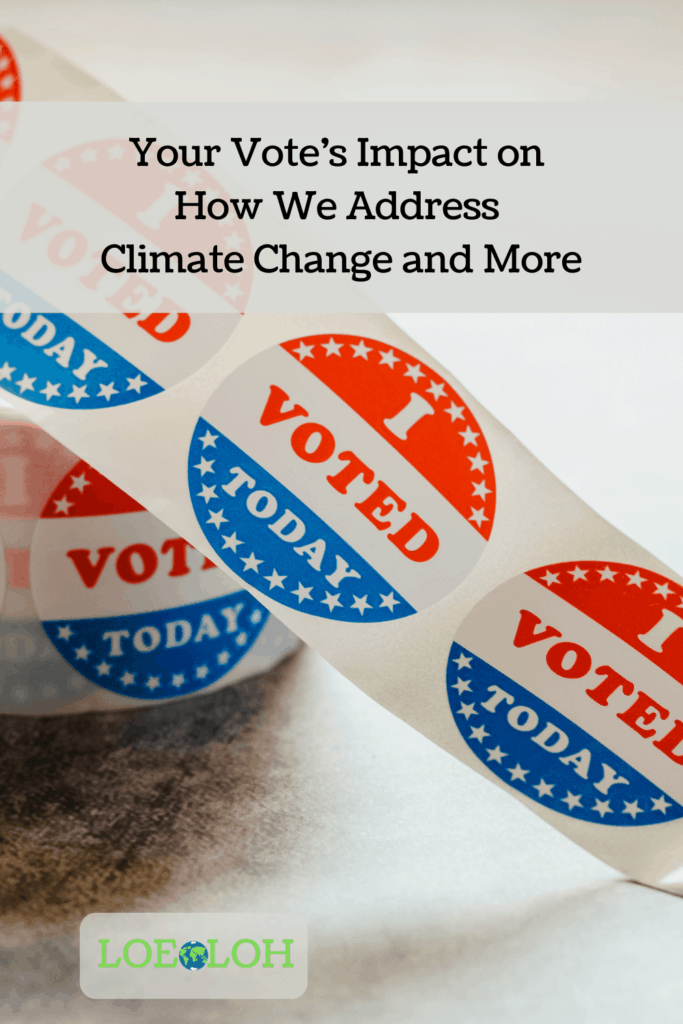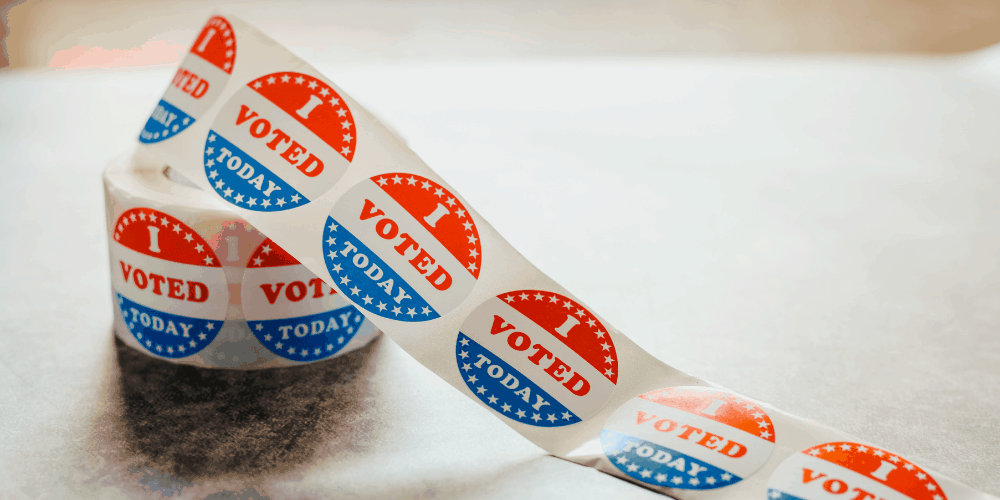It may seem with the estimated 232 million eligible voters in the United States that our one single vote isn’t going to affect how things turn out. However, we learned in the 2000 and 2016 presidential election, a president can win the election through the electoral college by a meager numbers of votes. Therefore, our vote does have an effect. Whether it is an effect you agree with or not, your vote has an impact on climate change and more.
In this post we are going to explore how your vote has an impact on addressing climate change and more. Starting with the impact of our vote with electing our president, touching on the electoral college system. Then we will consider what else is on our ballots, the copious other elected officials and ballot initiatives. Next, we will review the effects elected federal, state, and local officials have made on issues like climate change and other national concerns. Lastly, we will revisit the notion that our single vote isn’t going to affect how things turn out.
Hopefully, once you’ve reviewed how your vote has an impact, you will be ready and willing to vote in every upcoming election. With this in mind, at the end of this post there are a few resources to help you get your vote in.
So, How Does Your Vote Impact How We Address Climate Change and More?
Your Vote’s Impact on our next President of the United States and the Electoral College
Depending on what state we live in, your vote and my vote may weigh differently towards the Presidential election. This is because of the electoral college.
Unlike other elected officials in the United States who are elected based on winning the majority of individuals’ votes (popular vote), the President wins by receiving at least 270 of the 538 electoral votes. The Electoral College is made up of electors, who cast the electoral votes. Every state including the District of Columbia, has at least 3 electors. The number of electors from each state is determined by the state’s population.
In all states, except Nebraska and Maine, the Presidential candidate who wins the popular vote of the state, typically receives all of the electoral votes of the state. For the Electoral College system, you have states who through the popular vote will typically vote Democratic or Republican, called Safe States. Other states who are not as consistent between the Presidential elections, are called Swing States.
Some voters have noted frustration with the electoral college system because individual votes from different states carry more weight than others. The 2016 presidential election is an example of the contrast of the popular vote compared to the electoral votes. Hilary Clinton won the popular vote by over 2 million votes. Where as President Trump because of 80,000 votes in 3 states, won 306 electoral votes. Thus winning the electoral college and the Presidency. In short, due to the electoral college, individual votes from certain states are more influential for presidential elections.
Who and What Else We Vote On
In addition to our President of the United States there are nearly 520,000 government officials who are elected into their positions by us. These elected officials represent you and I at the Federal, State, and Local level of government. At all three levels, they make, interpret, and enforce laws and regulations. Thus the decisions made by government officials can have a lasting and expansive effect.
Along with elected officials, some state and local governments include ballot initiatives to be voted on during elections. These ballot initiatives have the potential to generate, modify, or remove specific state and local regulations. When ballot initiatives are on the ballot, it is a chance for us as voters to directly vote on policies.
As powerful as the President of the United States is, our federal, state, and local elected officials influence our daily lives as well. Fortunately, every election is an opportunity for us to choose who best represents us and what we value.
The Decisions of Elected Officials Impact How We Address Climate Change and other National Concerns
Once our elected officials’ are in office they make numerous decisions which impact our lives and our futures. The following are examples of the decisions various elected officials have made that affect how we address climate change and other national concerns.
Climate Change
Beginning with the presidency. Over the past century, environmental regulations and initiatives have gone back and forth between the different administrations. More recently, President Trump has worked to overturn 100 environmental regulations. As a result, experts expect increases in deaths from worsening air quality, and additional greenhouse gas emissions.
While the federal government has pulled back environmental regulations, state and local governments have stepped up. Elected officials in state and local governments around the country have passed several policies to address climate change. Many state and local governments have pledged to remain in the Paris Climate Agreement, even though the federal government withdrew.
National Concern: Public Education
Along with how we address climate change, our elected officials determine how we take on national concerns like our public education system. Prior to the Supreme Court Case, Brown vs. Board of Education (1954), the federal government had less of a role in education. State and local governments were primarily responsible for our education system. However, the ruling of Brown vs. Board of Education determined segregation as unconstitutional and provided the federal government the authority to ensure equal access to education for all.
Since Brown vs. Board of Education, federal policies commonly focus on providing funding to public schools dependent on if a school system is meeting requirements. Still most of the management and budget of public education is left to states and more so to local school districts. The local school districts are led by school board members who are usually either elected or appointed by elected officials. Local school districts are largely funded by local taxes determined by state and local governments.
How our elected officials address public education has an effect on the growth and education of children and also our economic future. In 2016 a report on education in the U.S. stated, “The U.S. workforce, widely acknowledged to be the best educated in the world half a century ago, is now among the least well-educated in the world.” To improve education, education expert, Jack Jennings, proposed that the federal government focuses on 3 fundamental components. They are: the student (focusing on preschool), the teacher (education and increase pay), and the curriculum.
The decisions of elected officials shape the outcome of national concerns, like climate change, our education system, and more.
The truth in the notion that our single vote isn’t going to affect how things turn out.
There is some truth to the notion that our single vote isn’t going to affect how things turn out. One vote out of the estimated 232 million eligible voters is a very small vote. When addressing problems as large as climate change, public education, and others, like racial inequality, the economy, and healthcare, our single vote alone is not enough to make a difference. Our one single vote is powerful when we are working together, pushing for changes that our present and future depend on.
Now we are all excited and wanting to vote, here are the 3 things you need to do to vote.
3 Things You Need to Vote
1. Register to Vote or if needed, Update your Voter Registration
In all states, except North Dakota, you must be registered to vote prior to election day. Check your local board of elections for more details on how to register to vote and the deadlines.
Additionally, TurboVote provides help with voter registration, how to vote by mail and can even send you election reminders!
2. Make your Voting Plan
Many of us are concerned there will be issues with voting this year, so make your plan NOW!
Check with your local election board to find out more on deadlines for absentee mail in voting, polling locations, dates and times. Does your state require an ID to be presented for voting? How will you get to your polling location? How will you protect yourself from COVID if you choose to vote in person? Could you and a friend meet up at the polling place?
3. Know Who to Vote for
Finally, do your research on the candidates on your ballot, to make sure you are prepared to choose who best aligns with your values. Ballot Ready is a nonpartisan resource to inform those interested in voting of who is on your ballot and information on the candidates up for election. You may even bring a printed sample ballot with you to the polls to help you remember who you have decided to vote for.
If you would like additional information on your candidates, Balletopedia is another resource.
See who of your candidates pledged to receive no more than $200 from fossil fuel industries. The No Fossil Fuel Money website provides information from presidential, federal, state, and local candidates.
Our government can move slower than we want or need them to. With climate change bearing down on us we cannot wait any longer. Each vote is either a step forward or backward in effectively addressing climate change and other issues as a country. We know our vote has an impact on how we address climate change and other issues. We have to vote in this election and every election moving forward. Let’s not vote alone. I encourage each of us to recruit 3 other family members, friends, or coworkers to vote with us. Go Get Out and Vote!

Image Credit: Roll of “I voted” circular stickers on a gray background for the November elections in the United States, by Joaquín Corbalán

